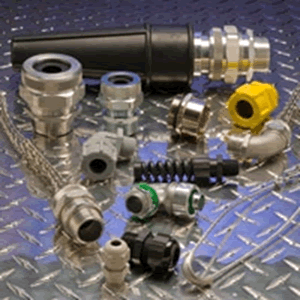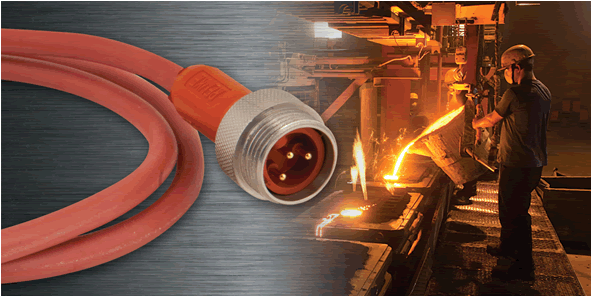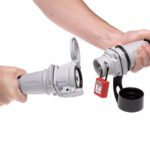Five Connector Specs to Combat Environmental Issues
There are simple ways to customize a connector’s performance to better withstand harsh environments. Remke examines the five connector specs that combat environmental issues.
 When establishing electrical connections in harsh environments, standard cable connectors and assemblies often don’t cut it. There are simple ways, however, to customize any connector’s performance.
When establishing electrical connections in harsh environments, standard cable connectors and assemblies often don’t cut it. There are simple ways, however, to customize any connector’s performance.
Common environmental issues for connectors include:
- Corrosion from water or chemicals
- Submerged connections
- Bending and flexing
- Extreme temperatures
- Tiny particulates
- Harsh materials that come in contact with connections
No matter what type of extreme environment you face, a few simple spec changes can make all the difference.
Customized Connectors Won’t Break the Budget
A common misconception about customized electrical connectors is that they are much more expensive than stock versions. That’s simply not true. The right manufacturer can meet custom specs without breaking your budget.
Customizations range from slight modifications to standard, stock connectors, all the way to manufacturing completely custom connectors. Depending on the environment and requirements, you can improve performance and easily meet your budget.
Below are features of customized connectors that can successfully overcome environmental issues to not only meet requirements, but perform above expectations to significantly reduce downtime and maintenance demands.
Connector Materials
Selecting the right materials for connectors and cable assemblies is the best way to ensure peak performance in harsh environments. Cutting-edge materials outperform standard aluminum or stainless steel, especially for corrosion and extreme temperatures.
- Valox seals out water and chemicals to prevent corrosion over time. This non-hydroscopic material is completely submergible.
- Nylon enhances corrosion resistance and durability in corrosive and wet applications.
- For a wet environment, upgrade to 316 stainless steel or nylon to prohibit corrosion over long periods of time.
- Silicone is ideal to combat extreme heat and freezing cold. It is also ideal for contact with chemicals and other highly corrosive elements.
- Viton fights corrosion from chemicals and retains high performance in extreme cold temperatures.
- Nickel-plated aluminum offers the resistance of stainless steel at a lower price point.
- Anodized aluminum enhances corrosion resistance and reduces conductivity to minimize the chance for sparks or faults.
Connector Components and Design
When considering all of the components in a connector and its overall design, small modifications can make a big difference in long-term performance and ease of use.
- Add O-rings to create a watertight seal inside nearly any connector.
- Lock-nuts are ideal for creating a very tight seal with minimal tools and effort.
- Wire mesh grips provide additional strain relief for bending and flexing to help prevent cable pullout in vertical runs or on machinery that is constantly moving.
- A nickel-plated ferrule will protect the cable, while adding overbraiding to the cable will allow it to easily slide on to the ferrule with a stainless steel clamp, ensuring a tight environmental seal.
- Pass-thru electrical connectors seal out liquids when a wire passes from the inside of a fluid container to the outside. This type of connector design is especially valuable in vehicle manufacturing.
- Multiple-hole bushings in silicone or neoprene stand up to the elements and can accommodate multiple cables and multiple cable types (like flat and round) to save space and ease maintenance.
Cable Length and Materials
Cable material itself can be customized to withstand the elements, especially outdoors and in chemically charged environments. In addition, using the right cable length makes the most of available space and reduces cable pull-out and the possibility of accidentally severing cables.
- Teflon wire, instead of 16 or 18AWG cable, better resists chemical breakdown from abrasive fluids, like transmission fluid.
- UV-Resistant, black, type SOO-W cable is ideal for outdoor use, as it is highly resistant to weather, sunlight, water, and ozone.
- Silicone cable is ideally suited for high-temperature applications.
- Custom cable lengths allow you to maximize space, reduce pull-out, and eliminate the chance of cables getting severed.
Overmold Materials
For molded connectors, including M12 and M8 connectors, the overmold material can help keep out the elements, and also improve strain relief for bending and flexing applications.
- Epoxy potting compound can be used instead of standard rubber overmolding material.
- Molded, tapered rubber cones provide additional strength in applications with extreme bending and flexing. Matching arc-of-bend specs can entirely eliminate cable damage.
Distribution Boxes
To easily secure multiple connections in smaller spaces, and maintain them more quickly, distribution boxes are the answer. But did you know they can be customized to withstand the elements?
- Multi-port distribution boxes are highly configurable to overcome environmental issues and meet space requirements.
- Some materials can help seal out the elements when used to construct distribution boxes. Consider stainless steel hardware, polyester resin for the box, and stainless steel or anodized aluminum legend plates for long-lasting environmental protection.
- Footprints can be modified to match pre-designed spaces.






